Basically, I met Comanescu on the road. In a car. We were on our way to Vâlcea, where Gorzo was having an opening. Remembering those moments, I was thinking, as I was preparing to write this text, that the wandering nature of my meeting with Nicolae Comănescu had, perhaps, a premonitory air to it; for here I am writing again about one of his endeavors, that happened on the road: an exhibition whose seed was extracted from a place far from Bucharest where we go about our daily lives. All this is due to Nicolae Comănescu having spent a big part of 2022 away from Berceni, which is the epicenter of his creative impulse. Perhaps the longest of his artistic career of almost three decades.
The artist was in Reșița, where the initial purpose was to document and meditate on the continuation of the project “SCRAP METAL KABOOM ORCHESTRA” (a project made in 2021 which I will fully present below), but in the meantime, he came up with the idea of the intervention Worse than Death, an installation with bags, inspired by the fortification gestures of public monuments in Ukraine. The “protection” gesture was concentrated around the Heroes’ Monument made by Constantin Lucaci and located in the Tricolor Square in Reșița. In theory, the whole implementation site was expected to take a week to prepare. In practice, it took a month. He spent the whole time there, carrying bags, enduring nasty comments from bystanders, talking to reporters, arguing with some workers, befriending others, and welcoming volunteers eager to help. The intervention could be visited for two months and revealed the gaps in Romanians’ contact with art in the public space. The installation stirred up many debates on Facebook, it became the inspiration for articles (written by specialists, but also by authors of blogs who compiled – on this occasion – curses) and euphoric poems. It was the main subject of gossip and disputes for a long time. In other words, it has raised public opinion from its acute numbness; meaning, it stirred reactions.
But this stay only helped him to consolidate his knowledge of Reșița, which he had gathered during his other trips there. As I mentioned, “SCRAP METAL KABOOM ORCHESTRA” is a result of his residency in the city, invited by the City Hall. Comănescu was called in for the restoration project of the Pittner house, a building that served as an important school in the area, under the guardianship of the family of the two teachers August and Helene Pittner. In the same context, he explored the city’s steelwork, which still retains some of the furnaces, towers, and other structures that today shape the post-industrial landscape. Here he began a classic type of research, taking photographs, sketches, and notes. But he also made his own specific extractions: he gathered earth, rubble, clay (from the crushed unburnt bricks), rust, and slag, which he integrated into the surface of the canvas. A series of 44 works entitled “SCRAP METAL KABOOM ORCHESTRA” is therefore being exhibited selectively in multiple spaces: the Pittner School (1 June 2021), Cărturești Carusel (2 March – 1 April 2022) and H’art Malmaison (curators: Smaranda Ciubotaru and Dan Popescu, 9 September – 20 October 2021) in Bucharest, Constanța Art Museum (curator: Mădălina Mirea, 1 September – 2 October 2022), the House of Arts in Timișoara (28 October – 15 November 2022).
Nicolae Comănescu was invited to Reșița to “preserve the repugnant immaterial,” to identify, collect, and, most importantly, to repurpose; because he has been putting features of geographical sites on his canvases since 2006. That’s when he started the “Dust and Powder” series, where he even mixed the two elements (he also used mustard, some soil in front of his apartment, and cigarette ash) with an acrylic medium, integrating the mix into compositions inspired by the Berceni neighborhood; a context that revealed the delirious dreams of the inhabitants of Bucharest at a time when their lives were increasingly shaped around media and consumerism. He went on with the series entitled “DNA: Dust and Narrative Analysis,” for which he also used ash as a material. We, thus, observe how, by capturing a moment that he isolates in time and space on a canvas, Comănescu creates his own “tempor(e)ality”; a hybrid universe, based on its own observations, experiences and feelings about the surroundings and/or about itself in relation to them, in a specific space-time. This hybridization comes from the coagulation of purely visual information – signs meant to unfold exclusively on the surface of the canvas – and some extra-visual, “presumed stories, mysterious encodings of one’s DNA, things meant to create inflation and increased consistency of the painting.”
Hence, his works become “repositories of historical discourses,” archives of meaning that contain/support “future transformations of the ruins.” Comănescu detects the potential of the waste-object, anchored in the past/decay, and reintegrates it into the present by surpassing its functionality. This approach encompasses historical references whose symbolism is lost in the contemporary environment bent towards innovation and oblivion. In this case, the artist can be compared to an archaeologist who uses his canvas as a cabinet of curiosities, where he records his “discoveries” on the foundations of the “taxonomies” that have made him famous, while also treating the characteristics of the new pieces. Therefore, we see how in the “SCRAP METAL KABOOM ORCHESTRA” series the specific neo-expressionist chromaticism becomes undermined by neutral tones, seemingly rendering the rusty atmosphere of the post-industrial setting of Reșița. But Comănescu doesn’t completely discard his apparent chromatic debauchery, instead resorting to vibrant intermezzos, which in tandem with dynamic perspective form powerful diptychs. In turn, they can be related, on the one hand, to a fading past and, on the other, to an overflowing potential future. The frames function as a conductor of dynamism, sometimes revealing a cinematic atmosphere. In this way, the works can be seen as stand-alone landmarks, functioning coherently once extracted from the series and as individual pieces.
Translated by Popescu Liliana
POSTED BY
Lina Țărmure
Lina Țarmure (b. 1999) is a curator and cultural manager. She graduated from the Faculty of Art History and Theory at UNArte, and is currently pursuing her master’s studies at the same department, ...


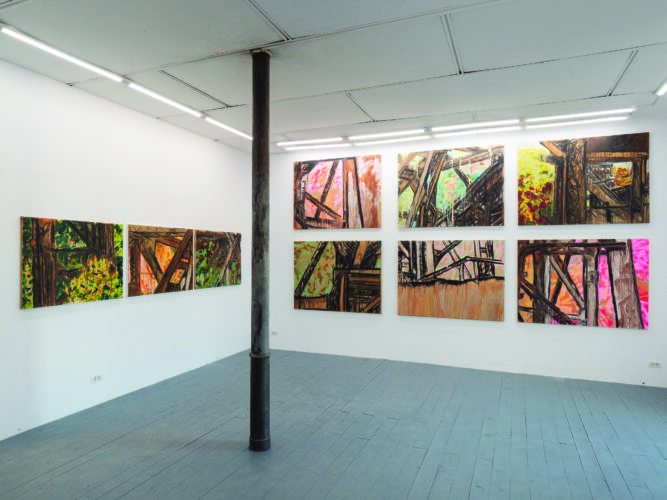
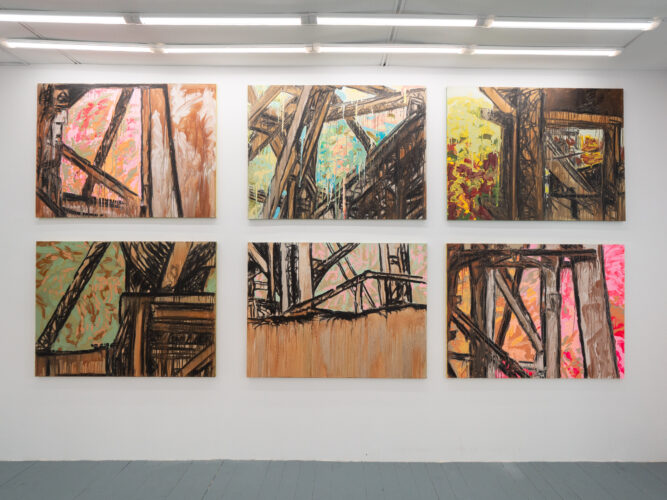
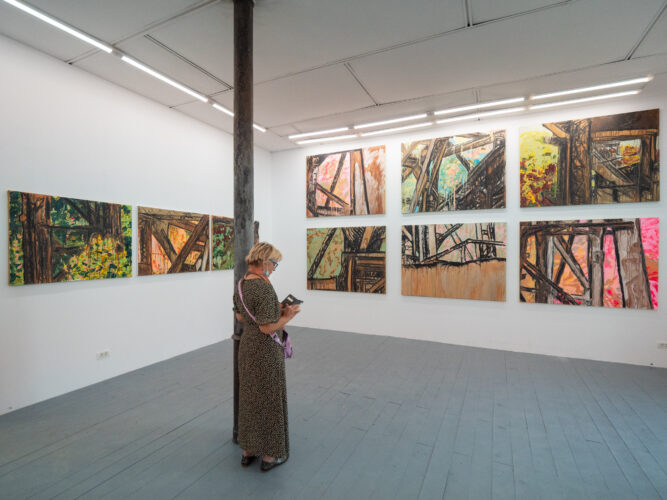
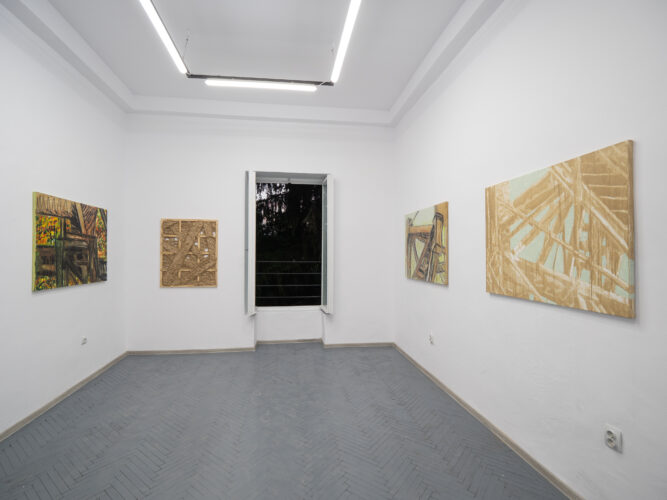
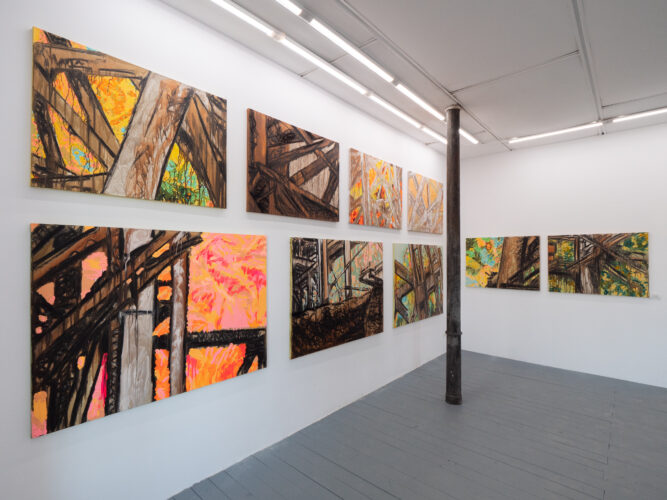

Comments are closed here.